icon
password
Multi-select
tags
ID
type
status
slug
summary
category
date
Author
URL
To foreign gormandizer, all Chinese dishes that require food to be cooked in a boiling hot pot are often mistaken for hot pot.
Hotpot is one of the most iconic Chinese cuisines, and there are many different types of hotpots in different parts of China that do not have the same flavor.
But in fact, the most famous and most common Sichuan hotpot has given rise to 7 different cuisines in China. It is not easy to distinguish between these cuisines, as some of them differ only in the way the plates are presented, while others differ only in the ingredients.
On the Internet in China, someone has created a “family tree” about hotpot, which briefly summarizes the “whole family” that is derived from it.
So stop calling everything you see a hotpot.
If you are visiting China, or if a Chinese restaurant similar to hotpot appears in your neighborhood, you can use this article to identify them.
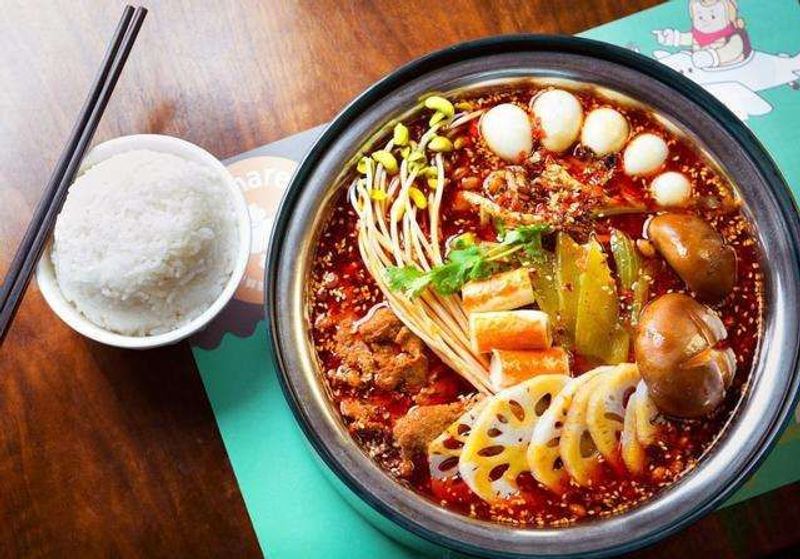
Maocai
Maocai
Chinese: 冒菜; pinyin: màocài
You can simply think of a Maocai as a hotpot where someone else cooks your food for you.
Everyone knows how to eat hotpot – diners sit around a table with a hot pot with a flavor base that put in the middle of the table. Each person picks up the ingredients with chopsticks, places them in the hotpot, and returns the cooked ingredients to his or her plate a few dozen seconds later.
The usual way of dining at Maocai is that you enter a store with an open shelf, and you act like a buffet.
Pick all the ingredients you want into your tub and give them to the waiter. The waiter will weigh the ingredients and tell you the price. After you pay, those ingredients will be taken to the back kitchen where there is a huge hot pot. The chef will pour all the ingredients into that bigger hot pot, cook them, put them in a big bowl, and then pour a few big spoonfuls of hot pot in the bowl Soup.
You are reading Panda!Yoo
A blog about modern Chinese culture and consumption trends. If you are interested in Chinese food, drinks, games, movies, novels, dramas, please follow us.
Join 1,565 other subscribers
Eventually, the waiter brings the Maocai to the table, and you can serve it with dried chili powder and rice.
Maocai originated in Chengdu, and the saying goes “Maocai is a hot pot eaten alone. Hot-pot is a Maocai for a group of people.”
Maocai is better for one person, and because you don’t have to cook food at the table, it will leave behind fewer Food scents on clothing, and cooking all ingredients at once also saves more time. This convenience makes it a workday lunch for many.
In China, Maocai is so common that there is no particular brand of Maocai that is well known. You can find different brands of Maocai restaurants all over the country, and even in some company canteens.
The Maocai brand is almost non-existent overseas, but some hot and spicy brands offer Maocai as well.
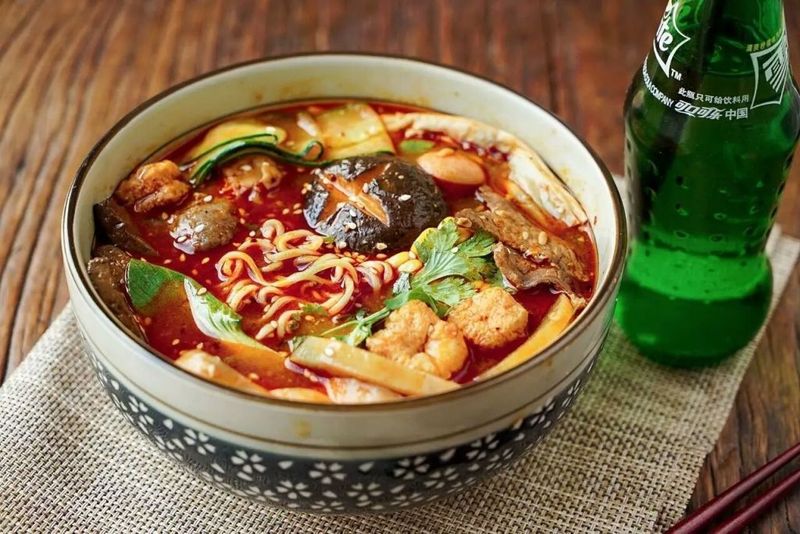
Spicy Hot Pot
Chinese: 麻辣烫; Pinyin: má là tàng
Spicy Hot Pot is another kind of hot pot that someone else cooks for you, just like Maocai.
Even many Chinese find it hard to tell the difference between Spicy Hot Pot and Maocai. But there is actually a significant difference between them: all the ingredients needed for spicy hot pot are worn on bamboo sticks, except that there is almost no difference from Maocai.
Unlike another hot pot variety, Chuan Chuan, the ingredients are removed from the bamboo stick before putting into the pot. The finished product obtained by the diner is almost the same as the Maocai in appearance.
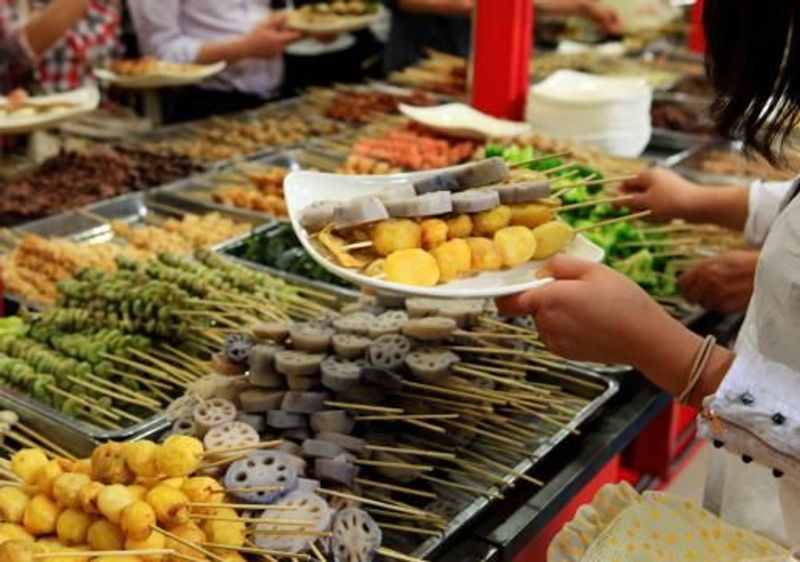
Although Spicy Hot Pot is similar to Maocai in the final product, one way to choose ingredients is by the piece, and the other is by weighing.
According to some introductions, the history of Spicy Hot Pot is no more than 30 years.
Spicy Hot Pot has the same ingredients as hot pot, but because the ingredients are strung on bamboo sticks, some too soft ingredients-such as tofu-disappear.
But now, most Spicy Hot Pot in China is almost no different from Maocai, and they are also sold with rice. There are two well-known spicy hot chain brands in China. One is Yang Guofu, the other is Zhang Liang.
Although spicy hot pot originated in Sichuan and Chongqing, the founders of both brands are from Harbin. Moreover, Yang Guofu is Zhang Liang’s cousin’s husband.
This is related to the wave of unemployment in Northeast China at the beginning of this century. During that time, many northeast workers laid off from state-owned enterprises used severance pay to open different types of restaurants across the country, which indirectly led to the birth of many Chinese restaurant chains.
Overseas, the spicy hot pot may be the only variety of hot pot you can eat. In Australia, the more well-known brand is David’s Spicy Pot. There is a Zhang Liang Spicy Hot Pot restaurant in New York and Canberra, Canada. Yang Guofu has a store in Tokyo, Singapore and Seoul.
Street food version Chuan Chuan and restaurant food version Chuan Chuan
Chuan Chuan
Chinese: 串串; Pinyin: chuàn chuàn
Chuan Chuan probably originated from the chef’s attempt to turn hot pot into street food in Sichuan and Chongqing. Chuan Chuan is the name for bamboo sticks in a Chinese dialect.
Different ingredients are strung with bamboo sticks, and there is a pot boiling all the time on the roadside table. Diners choose their favorite Chuan Chuan from the table and put it into a boiling pot, waiting for the ingredients to be cooked and eaten.
Unlike Spicy Hot Pot, the diner’s food ends up getting is still on the bamboo stick. This saves chopsticks and is convenient for standing up to eat.
You can place orders for multiple rounds, eating while waiting for the next order to be cooked and chatting with friends.
Another difference between Chuan Chuan and Spicy Hot Pot or Maocai is that it is never eaten with rice. Because as a kind of street food, it is more like a snack after dinner.
But in recent years, there has also been a version of Chuan Chuan,, which is basically a hot pot with ingredients strung on bamboo sticks and can be used with rice. But not as authentic as the street food version.
Similarly, there are no well-known Chuan Chuan brands, either overseas or in China. Even to some extent, only those Chuan Chuan spots with no brand at all are the most authentic, and you can only find them in the night markets of southern Chinese cities.
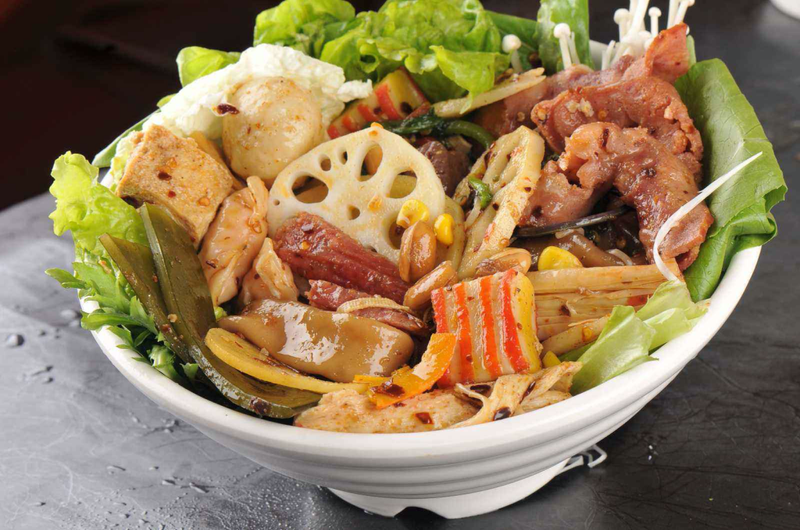
Did you find the difference between it and Spicy Hot Pot? It doesn’t contain any soup.
Spicy Mix
Chinese: 麻辣拌; Pinyin: má là bàn
The spicy mix is a kind of Spicy Hot Pot without soup. If you have forgotten what Spicy Hot Pot is, you can go back to the previous part of this article to review.
The difference between spicy mix and all of the above is that it uses clear water instead of a flavored soup bottom when cooking. Remove all the ingredients from the pan after they are cooked, then stir the food with a special hot sauce until the temperature drops.
The spicy mix benefits are obvious-it’s cooler than other hot pot derivatives, which means you don’t sweat from eating it in warm weather.
Like Chuan Chuan, it is a street snack and originated in northeast China.
The highlight of the spicy mix is the sauce, which is seasoned after cooking, so there are more flavors to choose from. The classic taste is the same as Spicy Hot Pot and consists of chili oil, salt, gourmet powder, chopped peanuts, cumin, pepper, and sugar. But for those who can’t eat spicy food, it also has sweet and sour versions and soy sauce versions, using vinegar and tempeh instead of chili oil.
Or you can direct the chef to combine any of a dozen seasonings, just like Subway sandwich.
Similarly, as street food, there is no well-known brand. But the spicy mix is often sold in the cooking areas of some Chinese supermarkets. The chef will put the finished spicy mix in a plastic bowl and then put on a plastic bag to make it easier for diners to take it home.
But fortunately, in most cases, you can ask Spicy Hot Pot stores to make spicy mixers by telling the waiter before placing an order.
Of course, there is also a very unauthentic way to buy a box of salad from the supermarket, cook it, and then add Chinese seasoning.
Of course, there is also a very unauthentic way to experience it: buy a box of salad from the supermarket, cook it, and add Chinese seasoning.
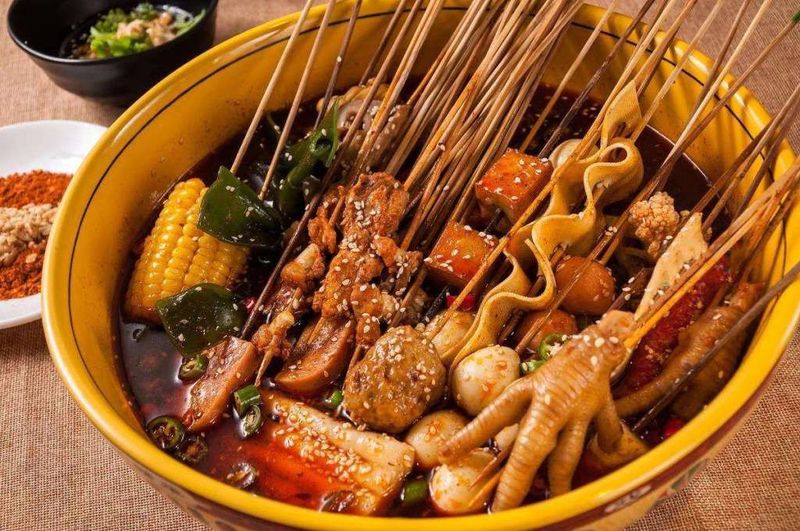
Cold pot Chuan Chuan
Chinese: 冷锅串串; Pinyin: lěng guō chuàn chuàn
To put it simply, a cold pot Chuan Chuan is a kind of Chuan Chuan that someone else cooks for you.
Do you remember how to eat Chuan Chuan? It is the street snack version of hot pot. People cook their favorite ingredients in pots provided by street vendors.
The most significant difference between Chuan Chuan and this is. When you eat cold pot Chuan Chuan, you need to give the selected Chuan Chuan to the chef, who will finish the cooking. You will eventually get a large bowl of cooked Chuan Chuan and some soup.
So, cold pot Chuan Chuan is somewhat similar to spicy hot pot, except that in the end, the food you get is still strung on a bamboo stick to facilitate consumption on the move.
It is worth noting that the cold pot Chuan Chuan is not cold, cold pot means that when the food is ripe, they will be taken out of a hot pot into a cold pot to the diner.
Bobo Chick
Chinese: 钵钵鸡; Pinyin: bō bō jī
Bobo Chick is a variant of cold pot Chuan Chuan. Bobo is the name for Pottery Bowl in the Chinese dialect.
To some extent, it is a Chuan Chuan meal with chicken as the main course. Bobo Chick is usually sold by set, so you don’t have to choose ingredients.
Its main ingredient is boneless chicken, different stores with different side dishes, and some Bobo Chick only chicken.
All the ingredients are strung on bamboo sticks to make it easy to eat.
- Author:NotionNext
- URL:https://pandayoo.com/2020/06/07/7-kinds-of-pot-cuisine-that-you-shouldnt-call-hot-pot
- Copyright:All articles in this blog, except for special statements, adopt BY-NC-SA agreement. Please indicate the source!